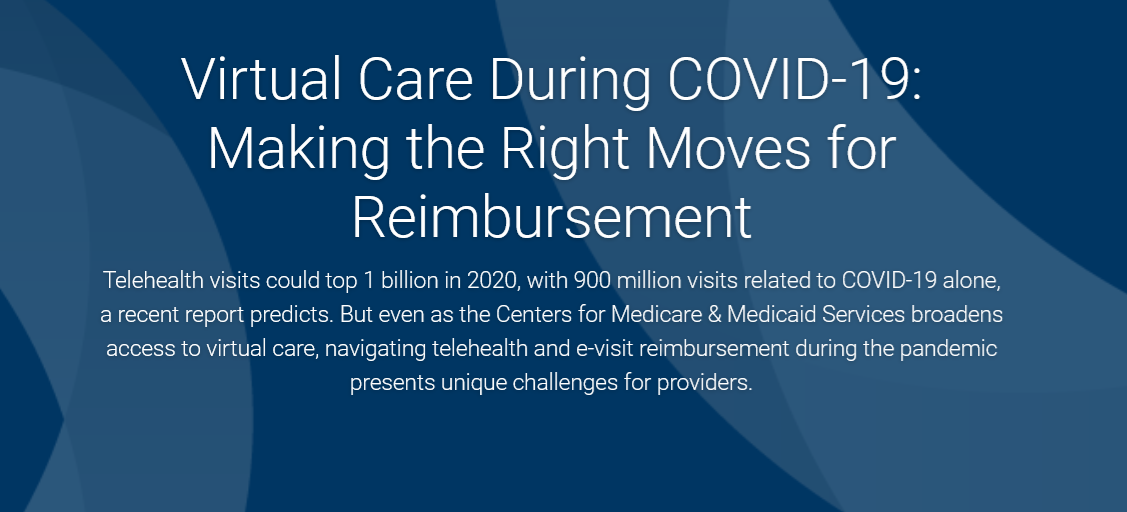SOURCE: The SSI Group
Telehealth visits could top 1 billion in 2020, with 900 million visits related to COVID-19 alone, a recent report predicts. But even as the Centers for Medicare & Medicaid Services broadens access to virtual care, navigating telehealth and e-visit reimbursement during the pandemic presents unique challenges for providers.
In March alone, virtual visits surged 50 percent as fears surrounding the coronavirus unfolded and in-person visits became scarce. But the speed with which virtual visits are being ramped up by hospitals, practices and systems has put extra stress on revenue cycle staff, who must work quickly to understand the ins and outs of billing for these visits—typically from a remote work environment.
Here are three ways revenue cycle teams can more effectively navigate virtual care billing challenges.
Know how to differentiate between modes of virtual care. There are two types of virtual visits that have taken off during the COVID-19 outbreak:
- Telehealth, in which patients interact with providers by video or by phone via their computer or mobile device
- E-visits, defined as a patient-initiated evaluation and management (E/M) service that takes place electronically, usually using some type of secure messaging platform
In reviewing virtual visits among clients, we have found that providers that have high e-visit volumes do not have high telehealth volumes, and vice versa. In some instances, providers with low e-visit volumes are not aware that they can bill for such a service, such as a medical consultation delivered via email.
Not all commercial payers cover e-visits; Medicare, managed Medicaid, and provider-sponsored health plans are examples of those that do. Often, reimbursement for e-visits is low: about $11 to $33 per visit. But for physicians that spend a lot of time on e-visits, these dollars can add up quickly. It’s important to educate clinical staff on what constitutes an e-visit and the importance of documenting these visits for reimbursement.
Revenue cycle staff also should be aware of the codes established for e-visits:
CPTs:
- 99421 – OL DIG E/M SVC 5-10 MIN
- 99422 – OL DIG E/M SVC 11-20 MIN
- 99423 – OL DIG E/M SVC 21+ MIN
HCPCS:
- G2061 – Qual NonMD Est PT 5-10 MIN
- G2062 – Qual NonMD Est PT 11-20 MIN
- G2063 – Qual NonMD Est PT 21+ MIN
Generally, e-visits may only be billed for established patients, not for new patients.However, some payers are allowing e-visits for new patients to determine whether a telehealth or office visit is warranted while the COVID-19 pandemic is ongoing.
Understanding what’s covered—and what isn’t. While CMS lifted restrictions on the use of telehealth to treat Medicare patients, that doesn’t mean all telehealth services are covered by every health plan. One example of a service that typically isn’t covered: lactation consultant services for new moms. Additionally, there are intensive therapies—both physical and occupational—that are not able to be reimbursed as a telehealth visit. Other codes for which we have seen rejections when care is delivered virtually include:
- 96150 – Assess LTH/BEHAVE, INIT
- 96151 – Assess HLTH/BEHAVE, SUBSEQ
- 90640 – Brief Follow-Up Consultation
- 90887 – Consultation with Family
Establish an internal resource for staff education. Share lessons learned in billing telehealth and e-visits via the revenue cycle department’s intranet communication vehicle. Consider, too, establishing weekly “virtual roundups” where staff can ask questions of leaders and each other when working together in the same physical location isn’t possible. Telehealth and e-visits should be a standing agenda item, given the level of interest in these visits, which some experts believe isn’t likely to dissipate after the pandemic.
Questions staff are likely to have as telehealth visits and e-visits continue to proliferate include:
- Whether specific services can be billed
- When special condition codes and modifiers are required
- How these services need to be entered into the healthcare information system so that they can be billed
By proactively addressing these challenges now, alone or in partnership with a billing expert, revenue cycle leaders can increase revenue while preparing their staff for the “new normal” of care delivery after COVID-19.
Visit the SSI blog: https://thessigroup.com/virtual-care-during-covid-19-making-the-right-moves-for-reimbursement/

